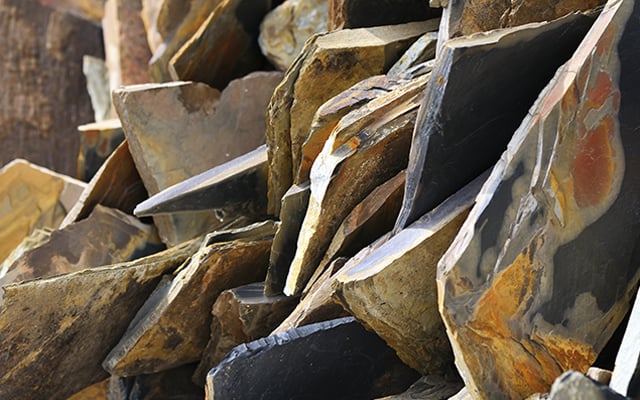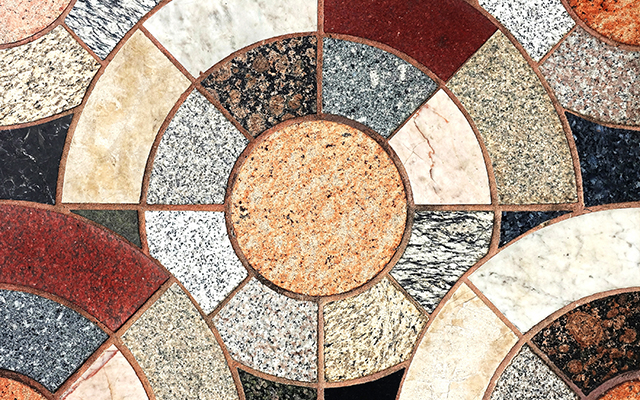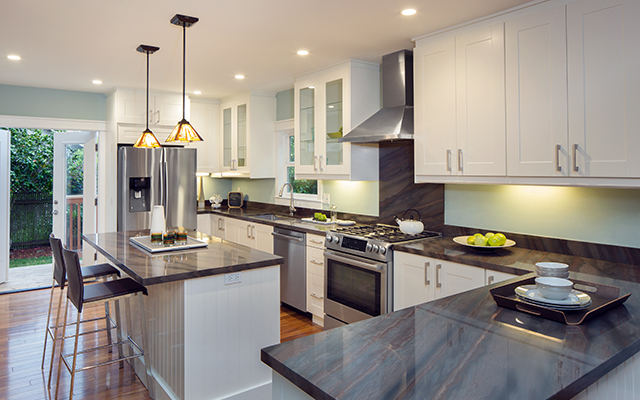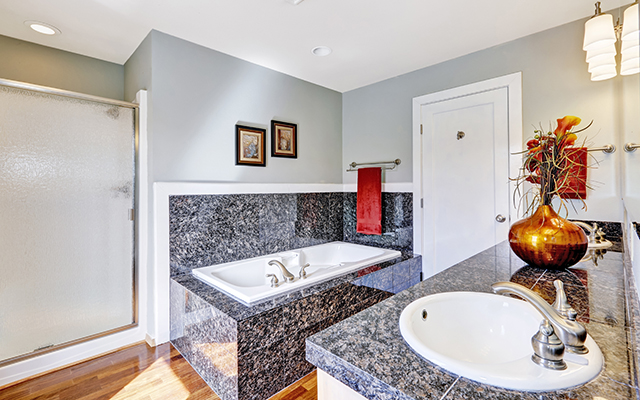Nature or Man – Who has the Countertop Advantage?
by Tammy Mastroberte
Posted: StoneWorld, December 10, 2003
Cutting through the circulating myths regarding both granite and solid surface countertops, each material presents its own set of pros and cons.
One of the biggest debates surrounding kitchen and bath design today is the choice of countertop material, and the two materials that are causing the most discussion are granite and solid surfacing. While granite is a natural, igneous material created underneath the earth’s surface, solid surface materials such as Corian and Avonite are man-made, using acrylic or polyester resins. This difference, along with many others, has caused both consumers and professionals to form various opinions regarding the maintenance, durability, design and cost of both products. Also, over time a number of myths have emerged regarding both materials, and this misinformation has added to the confusion. Instead of questioning which of the two is the better material, perhaps the question should be: is one material better than the other?
In comparing the pros and cons of both, the choice of material ultimately falls upon the consumer. Just as no two pieces of stone are alike, no two kitchens are alike either. In addition to layout and overall design, the practical needs and preferences of its occupants contribute to the material chosen for a particular kitchen. Additionally, since stone is a natural material, its coloring and patterns can vary, and consumers who prefer a solid color or evenly distributed pattern turn to a solid surface material. “Some people are not ready for a natural stone. They feel that granite has deposits in it and you can’t get a plain color,” said Rupy Shah of Stone-Tec, Inc., in Garland, TX.
This year, the National Kitchen and Bath Association (NKBA) surveyed certified kitchen and bathroom designers regarding the design trends for the calendar year of 1998, and both granite and solid surfacing countertops were included. While the overall percentage of solid surface material use is greater than granite, its popularity has declined since 1995 and granite has increased. According to the report, “The percentage of jobs that include granite countertops has shown a steady rise over the three years covered in this report from a low in 1995 of 23 percent, to a high of 33 percent.” In contrast, solid surface use for kitchen countertops has declined from approximately 38% in 1995 to 35% in 1998.
Taking into account both practical and design related issues, granite and solid surface materials each offer a different set of options, and according to the NKBA survey, they both are remain equally popular today. However, the advantages and disadvantages of both are often unclear, and the information available can be misleading. “Whether you’re building a new home or remodeling your old, the selection of the proper kitchen countertop can be confusing,” said Fred Hueston of NTC Enterprises, a stone consulting firm based in Longwood, FL. “All questions can be answered by a basic knowledge of what’s available and their characteristics.”


Durability and Safety
When comparing the durability of a solid surface material with granite, the chemical make-up of both becomes very important. While solid surfaces are mostly composed of acrylic resins and polyester plastics, granite contains both quartz and feldspar. According to the Measurement of Hardness (MOH) Scale for stone, a piece of hard plastic ranks a two, while feldspar and quartz rank a six and seven, respectively. “Hardness is measured on a MOH Scale of 1 to 10, with 10 being the hardest, and granite is a seven,” said Hueston. “A stainless steel knife blade is around a six, so you cannot scratch granite with it.”
In contrast, solid surfaces will scratch more easily than granite, but according to solid surface manufacturers, are also much easier to repair, and this factor attracts many people. While a scratch may be sanded out of a solid surface by the owner, a scratch in granite can often require a professional in order to be removed. This is one of the major advantages advertised by the solid surface industry when comparing the material with granite. However, the missing piece to this puzzle is that granite surfaces are very difficult to scratch. “Granite is nearly impossible to scratch,” said Hueston. “In the 20 years I’ve been in the restoration business, I have never once been called to fix a granite countertop because someone scratched it.”
Another area of importance concerning the durability of kitchen countertops is their ability to withstand heat. When cooking, a hot pot or pan can be placed directly onto a granite surface without causing damage, while a solid surface will burn or melt.
According to DuPont Corian, a popular solid surface material, “Corian remains stable and undamaged in a range of 0 to 212 degrees Fahrenheit.” In its advertisements, the company advises to use a hot pad of trivet to protect the material, stating, “Hot pans, as well as some heat-generating appliances like frying pans or crock pots, can damage the surface if a hot pad or trivet is not used.” In comparison, granite can withstand pots and pans up to 900 degrees Fahrenheit. “The melting point of quartz is greater than 1,200 degrees Fahrenheit,” said Hueston. “A distinct advantage of granite is that when you’re cooking, you can put a hot pan directly on the surface. Also, while hot oil can have a tendency to melt a solid surface, if sealed properly granite will not melt.”
Although granite is more heat resistant, many solid surfaces are more resistant to both food and liquid stains. According to manufacturers, solid surfacing is non-porous, and is therefore better able to resist liquids and foods that can produce a permanent stain when compared to granite. However, with the proper sealant, granite can also be protected from staining. “In some cases solid surfaces are more stain resistant than granite, and since there are many manufacturers, stain resistance depends on the product,” said Hueston. “Some will be very stain resistant, while others will not be. But if sealed properly, granite can be just as stain resistant as a solid surface.” Hueston recommends that consumers do their own stain test and compare the results. “Test with products such as red wine, mustard, oil and ketchup. Let them sit a good 10 to 15 minutes and see if they stain.”
Furthermore, since solid surfacing materials are plastic and non-porous, they are advertised by manufacturers to be resistant to the growth of bacteria and mold. The fact that they are seamless also adds to their durability in this area, manufacturers state. But neither its porous nature nor installation seams rule out granite as a safe countertop material. “There are stone cooking utensils that have been sold for years,” said Hueston. Also, the penetrating sealers available for granite do not only resist stains, but also reduce the likelihood of bacteria and mold growth. Due to customer concerns about the safety of granite regarding bacteria and mold, Hueston contacted both The Center For Disease Control (CDC) and The National Institute for Occupational Safety and Health (NIOSH) a year ago. “I asked them to do a keyword search to look and see if there were any recorded cases where bacteria was a concern with granite,” said Hueston. “They came back with zero cases.”
Damage Repair
When considering a material for use in an area where food and liquids are abundant, damage is always a concern. Burning, nicking, cutting and staining are some examples of damage that can occur, depending on your countertop material. And no matter what material is chosen, none offer 100% protection from all of these problems. So what happens if a stain sets in on a granite countertop, or a solid surface burns? Both materials offer solutions to these possible situations, with advantages and disadvantages that accompany each.
Because it is a man-made material, solid surfacing reveals the same pattern and coloring throughout each layer, and with regard to damage repair this can be an advantage. “A solid surface is homogeneous, which means it is the same all the way through from top to bottom,” said Hueston. As a result, any cuts or scratches can be sanded away to reveal the same design. As advertised by DuPont Corian, “Corian keeps its good looks longer because the solid beauty of Corian goes all the way through. If a Corian surface is marred, there is plenty of renewable beauty right beneath the surface.” The procedure for removing a cut or scratch from a solid surface material varies depending on the finish, but most require a piece of sandpaper to smooth away the damaged layer, and an abrasive cleaner to restore the finish. Also, some manufacturers, such as Avonite, have repair kits available for their products. “Solid surfaces are designed to function on a consumer-friendly basis,” said Sharad Vajani of Transolid, a solid surface manufacturer. “They are designed to be easily repairable, and the rejuvenation of the surface is easier than granite.”
For a matte finish, Corian recommends a 180 or 220-grit fine sandpaper, while a 400-grit can be used for a high-gloss finish. After the cut or scratch is sanded away, a matte or semi-gloss finish can be restored using an abrasive cleaner, and a high-gloss finish can be buffed with a white polishing compound and low-speed polisher using a wool pad. Additionally, a difficult stain can be removed using an abrasive cleaner and a Scotch Brite pad for a matte or semi-gloss finish, and a white polishing compound and sponge for a high-gloss finish.
Compared to solid surfaces, granite appears more difficult to repair and can require a professional to be fixed if scratched. But again, granite is much more difficult to damage. “The only thing that could possibly scratch granite would be if a person would turn their diamond ring around and scratch the stone surface with it,” said Hueston. “If it was scratched, a professional would come in with an electric machine and sand the scratch out using a diamond abrasive to bring the surface back up and polish it. It is a very difficult thing to do, but it is very rare that it would have to be done.”
Despite the many sealants available for granite today, staining can and does occur. However, most stains can be removed by using a variety of methods depending upon the type of stain. For more difficult stains, a poulticing method is used and can be performed overnight. “I tell people to take a cup of flour and a tablespoon or two of liquid dish detergent and mix them together with water to make a paste with the consistency of yogurt or peanut butter,” said Hueston. “Apply it over the stain, and cover it with Saran Wrap. Let it sit over night and then remove the plastic and let it dry. Then scrape it away.” This method can be used to remove most oil-based stains, and for stains such as red wine, the dish detergent can be substituted with hydrogen peroxide.
In its brochure, Care and Cleaning for Natural Stones, The Marble Institute of America (MIA) lists other methods that can be used on stains that are less severe. A soft, liquid cleanser with bleach, a household detergent or ammonia can be used to flush out or rinse away oil-based stains such as grease, cooking oil or milk, and for organic stains such as coffee, tea and fruit, a 12% hydrogen peroxide mixed with a few drops of ammonia can be used. Additionally, for light-colored granite, hydrogen peroxide can also be used to remove ink stains from a magic marker or pen, but for darker stones, a lacquer thinner or acetone in recommended.
Although in some cases, repairing damage to a solid surface may be easier than granite, it does have some disadvantages. “Solid surfaces are easier to repair than granite but do scratch more easily, and with repeated sanding you may end up creating a dish in the countertop,” said Hueston. “In the hands of an inexperienced person, it can be sanded too much and actually place a dip in the solid surface.”
Everyday Care and Maintenance
In addition to damage repair, most people are concerned with everyday cleaning and care, and are looking for a material that requires little to no maintenance on a daily basis. “People want something that is basically maintenance-free,” said Sherry Barton of The Countertop Shoppe, Inc., in Naples, FL. “For example, if you put a cup down on a solid surface, it leaves a mark, but can be washed off with a dish detergent.” Overall, both materials do not require a great deal of maintenance on a daily basis, but again there are different procedures for both, and personal preference can be the deciding factor.
The biggest difference between granite and solid surfacing is resealing, and solid surfacing has the advantage in this area. Since a solid surface material does not require a sealant, aside from damage repair, it remains maintenance free except for daily cleaning.
However, a granite countertop will have to be resealed over time. “In a home environment, once every couple of years it needs to be resealed,” said Hueston. “In a commercial setting, food or beverage areas should usually be resealed every six months to a year, but it varies per manufacturer.” Nevertheless, unlike scratch removal, resealing does not require a professional, and can be done using an impregnator such as a penetrating sealer. “It literally soaks into the stone so you don’t see it,” said Hueston. “It’s invisible protection.” To reseal, Hueston recommends that the countertop be wiped down as usual with a neutral cleaner or product made for granite and left to dry. “You can pour on an impregnator or apply it with a cloth and let it sit a few minutes. Then just wipe it off.” Depending on the brand used, the drying process can take from 12 to 24 hours. “Different brands cure differently,” said Hueston. “But once it cures, it is safe around food.”
Aside from resealing, daily maintenance for granite is not difficult, and is easier than solid surface maintenance in some aspects. “I think granite is easier to maintain on a daily basis,” said Hueston. “The solid surface can require an abrasive cleaner, and granite only requires you to spray and wipe a neutral cleaner. Also, if bacteria is a concern, there are now disinfectant cleaners.” Solid surfaces can be wiped daily with soapy water or ammonia based cleaner, but sometimes requires the use of a Scotch Brite pad. Also, while granite can be cleaned and disinfected in one step, solid surfaces require a mixture of water and household bleach.
Regardless of the countertop chosen, each needs to be cared for properly. “All countertop materials need the proper care to keep them looking great,” said Hueston. “In food areas, a good anti-bacterial soap should be used, and all countertops should be cleaned immediately after food preparation. Water should not be allowed to sit and puddle.”


Design Flexibility
When it comes to creating a specific look or appearance, granite and solid surface countertops offer different benefits, and although some of the same options are available with both, each material has its own look. While solid surface materials can offer a more homogeneous look, granite creates a unique appearance, with patterns that may vary from one piece of stone to another.
Because granite is a natural material, it does not produce the standardized look of a solid surface. “With granite, the pattern is not the same everywhere because it is God-made, but a solid surface will look the same throughout,” said Barton. Also, granite countertops are not seamless, which can be a disadvantage for those who prefer a consistent look. “Stone has a more unique and custom look. It’s like an original painting,” said Hueston. “I would want something original that would make my kitchen stand out amongst everything else, and stone is the only thing that is going to do that.”
However, if a uniform appearance is desired, granite should not be entirely ruled out. According to MIA, “The minerals in granite will typically appear as small flecks distributed uniformly in the stone. Many commercial deposits display remarkable homogeneity; the rock may not vary in color or texture for many feet, either vertically or horizontally.”
While most design features are a matter of taste, solid surfacing offers little limitation in terms of size and shape. “Being a man-made material there are no limitations to the size of the pieces, and it can also provide seamless corners,” said Chuck Monson of Dakota Granite in Millbank, SD. Solid surface materials can be cut to any size, and can be thermoformed to eliminate visible seams or voids. Also, they are available in solid colors as well as speckled patterns, which appear like granite. These factors add to the homogeny of the material, and its seamless nature reduces the possibility of collecting dirt within the seams, according to manufacturers. “Solid surfaces offer a more uniform appearance, if that’s the look your going for,” said Hueston.
Additionally, solid surface countertops can be shaped to create a coved backsplash and offer the option of sub-mounting, top-mounting or joining a sink of the same material without a seam. Transolid, a solid surface manufacturer that specializes in sinks and bowls, offers countertops with a sink and coved backsplash in one-piece for a bathroom vanity. Granite sinks are also available, but cannot be installed without a seam, and a granite backsplash is only available with a straight edge. “With the technology and installation methods of granite, the seam is a small price to pay for the beauty of it, and it is usually not noticed,” said Hueston. “Your eyes do not go to the seams.”
Material Expense
Many people rule out natural stone as a design material because of a common misconception that it is more expensive than solid surfacing. However, this is not always the case. “The general perception is that granite is more expensive and it’s not,” said Monson. “Granite and solid surfacing are very comparable in price.” In addition to the original cost, granite can save money over time. “A solid surface does not last forever, but granite does, so cost is better in the long run,” said Rupy Shah. “It used to be a myth that granite was only for the rich, but it’s really not. It’s for the average person because it lasts forever.”
Depending on the type of granite or solid surface material chosen, the price will fluctuate. “There are varying degrees and ranges of both, and some of the higher-end solid surface materials can be more expensive than granite,” said Hueston. “Sometimes they are equal in price, and other times a solid surface is cheaper than granite.” For example, if a solid color is chosen for a solid surface material, its cost will be less expensive than one with a pattern. “There are different family series’ and some have particulates or specs in them that appear like granite,” said Barton. “These are more expensive.” Granite will also vary depending on the type chosen. According to the MIA, “Many factors determine the price of a particular stone. Availability, ease of extraction, market demand, quality and transportation are a few of the variables that will affect the price.”
Another factor that contributes to the cost of both materials is the amount of fabrication involved. “The price of granite is usually controlled or dictated by the amount of fabrication necessary,” said Hueston. “If a bull nosed edge or undermount sink is needed, it requires more fabrication and is more expensive.” The same is true with solid surfacing. According to Barton, “If you’re doing a coved backsplash rather than a standard backsplash, or if we have to inlay a different color into the edge, there is a lot more labor involved and that would raise the price.”
Furthermore, the installation of a solid surface countertop is easier than granite, but this does not have a large effect on the price. “A solid surface is a little easier to install because it is lightweight and you would not need as many individuals to install it as you would with granite,” said Hueston. “But for the most part they are about equal as far as installation costs.”
After clearing away any false information and considering the pros, cons and various options of both granite and solid surface countertops, the final choice is ultimately up to the owner. Although both offer distinct advantages and disadvantages, what may be a disadvantage to one person may not be to another, and vice versa. “I would think if anyone investigated the advantages of granite versus a solid surface, they would come to the conclusion that granite is the choice,” said Hueston. “But, regardless of whether you choose a solid surface or granite, make sure you follow the manufacturers directions for care and maintenance,” said Hueston.
Sidebar 1: Measurements of Hardness Scale (MOHS)
Developed in the 1800s, the Measurement of Hardness Scale (MOHS) for stone evaluates the strengths and weaknesses of various stone types. Its main objective is to measure a stones resistance and hardness. The harder the stone, the more resistance it has to abrasion. On a scale of 1 to 10, 10 is the hardest.
While solid surfaces are mostly composed of acrylic resins and polyester plastics, granite contains both quartz and feldspar. According to the MOH Scale, a piece of hard plastic ranks a two, while quartz and feldspar rank a seven and six, respectively.
1. Talc
2. Gypsum
3. Calcite (most Marbles)
4. Fluorite
5. Apatite
6. Feldspar (Granite)
7. Quartz (Granite)
8. Topaz
9. Corundum
10. Diamond
